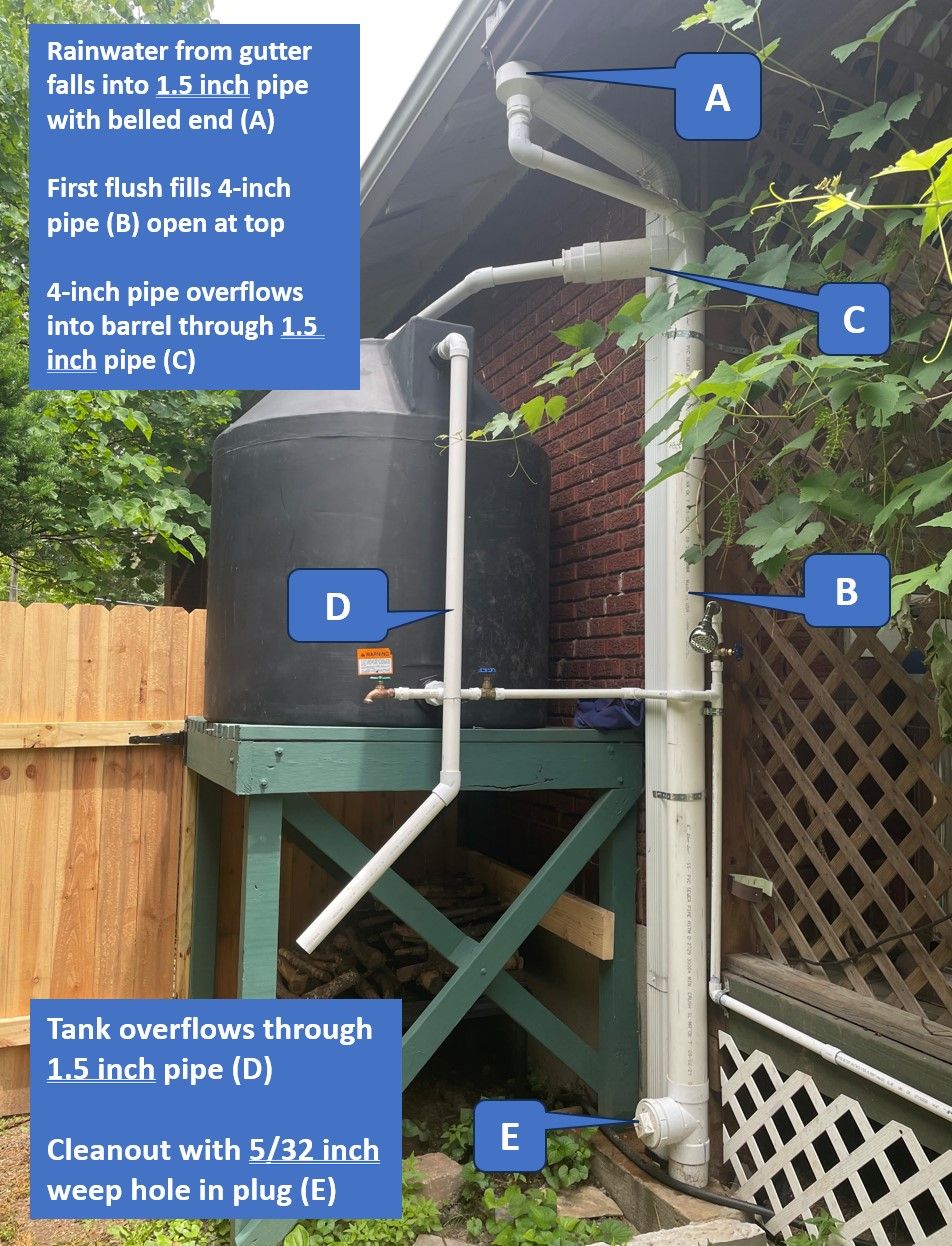
Harvesting Rainwater
In Springfield, tap water is cheap ― less than a penny a gallon. So why worry about how much you use? Many people don’t worry, of course, even though water conservation has been drilled into us since childhood. But when it comes to watering gardens and landscapes, there is no reason not to use harvested rainwater. In fact, I can give some good reasons for doing it.
Here are a few things to consider when designing a rainwater system: How much water do you need? Do you have a big garden, or one raised bed? A simple rain barrel will suffice for watering a few plants, but if you’re like me, you will soon want more rainwater storage.
Consider putting your barrel or tank on a raised platform. You get about 2.3 pounds per square inch (psi) of pressure per foot of height of the water surface above the ground. I like to water through a garden hose or a drip irrigation system (plastic pipe with holes), which works well at 15-20 psi (water surface 6 ½ to 9 feet off the ground). Make sure your barrel or tank is opaque, not clear or translucent. If sunlight gets to the water, algae will grow and you’ll soon have stinky green water. Make sure any openings into the barrel (e.g., top opening, overflow) are screened to prevent the entrance of mosquitoes.
Consider a “first-flush” diverter system. This keeps the leaves, shingle grit and dirt out of the tank that would otherwise enter with the first slug of water coming out of the gutter. Most rain barrels use a filter screen at the top to catch debris coming out of the downspout. But the barrel will still get a buildup of sludge at the bottom, and will probably have to be cleaned out at least once a season. There are commercial first-flush diverter kits available, but I made mine with a vertically mounted, 4-inch PVC pipe (see diagram). This system diverts the first 10 gallons of water that comes off the roof.
- Harvested rainwater is free ― no charge. Why not take advantage of something free that your plants will love ― soft, non-chlorinated rainwater?
- It’s fun to build rainwater catchment systems; back-of-the envelope engineering; the satisfaction of designing and building something that will operate for decades and require little maintenance.
- Rainwater is user-friendly. When I built my first system, a simple rain barrel, I watered tomatoes and a few potted plants. Now, I harvest over 600 gallons, and use it for all kinds of things besides watering plants ― make-up water for my pond and fountain; cleaning my hands after gardening; pre-washing root vegetables; cleaning bird feeders, compost containers, rain gauges, shovels, hoes, and trowels.
Here are a few things to consider when designing a rainwater system: How much water do you need? Do you have a big garden, or one raised bed? A simple rain barrel will suffice for watering a few plants, but if you’re like me, you will soon want more rainwater storage.
Consider putting your barrel or tank on a raised platform. You get about 2.3 pounds per square inch (psi) of pressure per foot of height of the water surface above the ground. I like to water through a garden hose or a drip irrigation system (plastic pipe with holes), which works well at 15-20 psi (water surface 6 ½ to 9 feet off the ground). Make sure your barrel or tank is opaque, not clear or translucent. If sunlight gets to the water, algae will grow and you’ll soon have stinky green water. Make sure any openings into the barrel (e.g., top opening, overflow) are screened to prevent the entrance of mosquitoes.
Consider a “first-flush” diverter system. This keeps the leaves, shingle grit and dirt out of the tank that would otherwise enter with the first slug of water coming out of the gutter. Most rain barrels use a filter screen at the top to catch debris coming out of the downspout. But the barrel will still get a buildup of sludge at the bottom, and will probably have to be cleaned out at least once a season. There are commercial first-flush diverter kits available, but I made mine with a vertically mounted, 4-inch PVC pipe (see diagram). This system diverts the first 10 gallons of water that comes off the roof.